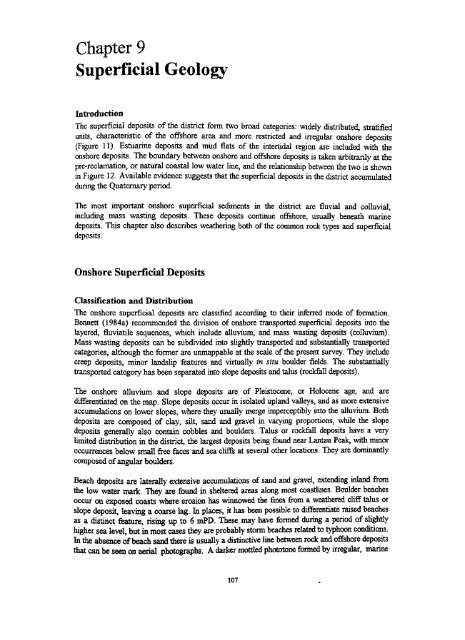1 - HKU Libraries
1 - HKU Libraries
1 - HKU Libraries
You also want an ePaper? Increase the reach of your titles
YUMPU automatically turns print PDFs into web optimized ePapers that Google loves.
Chapter 9Superficial GeologyIntroductionThe superficial deposits of the district form two broad categories: widely distributed, stratifiedunits, characteristic of the offshore area and more restricted and irregular onshore deposits(Figure 11). Estuarine deposits and mud flats of the intertidal region are included with theonshore deposits. The boundary between onshore and offshore deposits is taken arbitrarily at thepre-reclamation, or natural coastal low water line, and the relationship between the two is shownin Figure 12. Available evidence suggests that the superficial deposits in the district accumulatedduring the Quaternary period.The most important onshore superficial sediments in the district are fluvial and colluvial,including mass wasting deposits. These deposits continue offshore, usually beneath marinedeposits. This chapter also describes weathering both of the common rock types and superficialdeposits.Onshore Superficial DepositsClassification and DistributionThe onshore superficial deposits are classified according to their inferred mode of formation.Bennett (1984a) recommended the division of onshore transported superficial deposits into thelayered, fluviatile sequences, which include alluvium, and mass wasting deposits (colluviurn).Mass wasting deposits can be subdivided into slightly transported and substantially transportedcategories, although the former are unmappable at the scale of the present survey. They includecreep deposits, minor landslip features and virtually in situ boulder fields. The substantiallytransported category has been separated into slope deposits and talus (rockfall deposits).The onshore alluvium and slope deposits are of Pleistocene, or Holocene age, and aredifferentiated on the map. Slope deposits occur in isolated upland valleys, and as more extensiveaccumulations on lower slopes, where they usually merge imperceptibly into the alluvium. Bothdeposits are composed of clay, silt, sand and gravel in varying proportions, while the slopedeposits generally also contain cobbles and boulders. Talus or rockfall deposits have a verylimited distribution in the district, the largest deposits being found near Lantau Peak, with minoroccurrences below small free faces and sea cliffs at several other locations. They are dominantlycomposed of angular boulders.Beach deposits are laterally extensive accumulations of sand and gravel, extending inland fromthe low water mark, They are found in sheltered areas along most coastlines. Boulder beachesoccur on exposed coasts where erosion has winnowed the fines from a weathered cliff talus orslope deposit, leaving a coarse lag. In places, it has been possible to differentiate raised beachesas a distinct feature, rising up to 6 mPD, These may have formed during a period of slightlyhigher sea level, but in most cases they are probably storm beaches related to typhoon conditions.In the absence of beach sand there is usually a distinctive line between rock and offshore depositsthat can be seen on aerial photographs, A darker mottled phototone formed by irregular, marine107

















